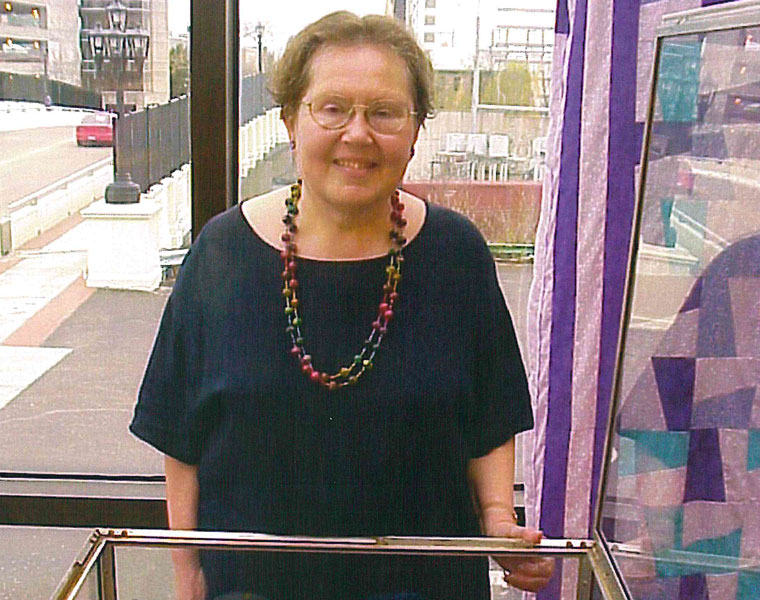Margaret Fischer came of age during President Dwight D. Eisenhower’s terms in the White House in the late 1950s. During that time, as she recalls, women were expected to become housewives who led lives supported by their husbands.
“Somehow that wasn’t the path I felt I was mapped out to take,” she said.
Instead, she found joy as an art instructor right here in University Circle. And now, more than 50 years later, she retired after decades as an instructor in Case Western Reserve University’s Art Studio Program.
Raised in Cleveland, Fischer made frequent visits to University Circle growing up, which is where she first uncovered her passion for art. Specifically, she took jewelry-making classes at the Cleveland Institute of Art—which she called her “happiness throughout high school.”
She went on to attend the art institute as a full-time student, first intending to pursue metalwork, but ultimately earning a bachelor’s degree in enameling.
“One of the happiest years of my life was my last year of art school, where I got up everyday, went into the studio for enameling and enameled all day long,” she said, thinking of the peaceful time she spent listening to classical music as she completed her work.
Upon graduation, she wasn’t sure where her career would take her. But just a few years later, she got a call that her former mentor suggested her for an open role at Case Western Reserve.
Fischer accepted the offer. To this day, she remembers watching the students filing into her studio as she greeted them at the door in 1971, just as they’d do in the years to follow.
Throughout her career, her students have primarily come from engineering and health-related fields. She’s taken pride in offering them a space to experience the arts, hoping to equip them with problem-solving skills and a connection to human nature.
Fischer can’t recall a single instance of offering negative feedback to a student, as she always opted to take an encouraging approach to their work.
“With art, especially when it comes to grading and in the comments you make to students, you’re not just grading or commenting on their artwork, you’re commenting on them as people. You’re commenting on their emotions, you’re commenting on their life experience. It’s always been important to me to be a positive force in that regard,” she said.
And while Fischer has happy memories of her students in class, it’s what came after they turned in their final projects that stands out most. She takes delight in seeing her past students succeed, including a former student who appeared on a Microsoft commercial, a faculty member who once took her class—and continues to rave about her to his students—and a lawyer she taught who she encountered during jury duty.
Recently, as she was reflecting on her career, Fischer realized her pupils have come from 36 different countries on six continents—and they’ve taken lessons learned in her classes with them on their life journeys.
“That’s been very eye-opening,” she said. “I have not been very well-traveled, but it’s like the world has come to me.”
Learn more about Fischer’s artwork and life experiences in this week’s five questions.
1. What is your biggest personal goal for 2023?
I don’t know why, but I find it so much easier to start artwork than to finish artwork. I probably have 6-12 pieces that I have not finished. Some are very close to finishing and I want to get some of the artwork finished.
2. How do you like to spend a day off from work?
I like to pursue an art form called orizomegami. It is folded paper and dyed. I use liquid watercolors and a paper called Dippity Dye, which is a little stronger than rice paper, but more absorbent. I fold any number of ways. I have made my Christmas cards that way. I made wrapping paper that way.
Another art form I pursue is shibori. It’s a fiber technique and it’s a resist-dyeing technique. I do [shibori] on silk scarves and I donate them to Seidman Cancer Center.
3. Who has inspired you most in life?
Mother Teresa. She always maintained the purity of heart throughout her life that served her well, as she worked only for the good of others. I always saw how profound and focused she was. I always saw how purposeful she was. And I attempted to apply that to the teaching especially, but of course to everyone.
Everyone you get in line with, everyone you drive on the street with: Be as good and kind as you can be. Make that other person a better person for the contact you have with them in every sense that you can.
4. Where would you most like to travel next?
In a word: Europe. I’m not very well-traveled. I spent very little time in Florence; I would like to go to the Uffizi, their art museum. There are some enamels I would like to see in Venice. I would like to go to the Chartres Cathedral to see the stained glass. I would like to go to the Cluny Museum in Paris to see the tapestries.
And I could always spend more time in the Louvre.
5. What’s your favorite thing about Case Western Reserve?
It’s not a very original thought and it’s probably cliché to say, [but] the people. There are so many extraordinary people in the student body, in the faculty, in the staff. All levels of the staff. It’s just amazing when you stop and think about these people—so many are so incredible, such marvelous people.
I’ve always loved University Circle. My whole life as a child, I would go in and out. I saw the King Tut exhibit at the [art] museum and Van Gogh exhibit at the museum when I was a child, and of course have been able to see some marvelous exhibits since then.


